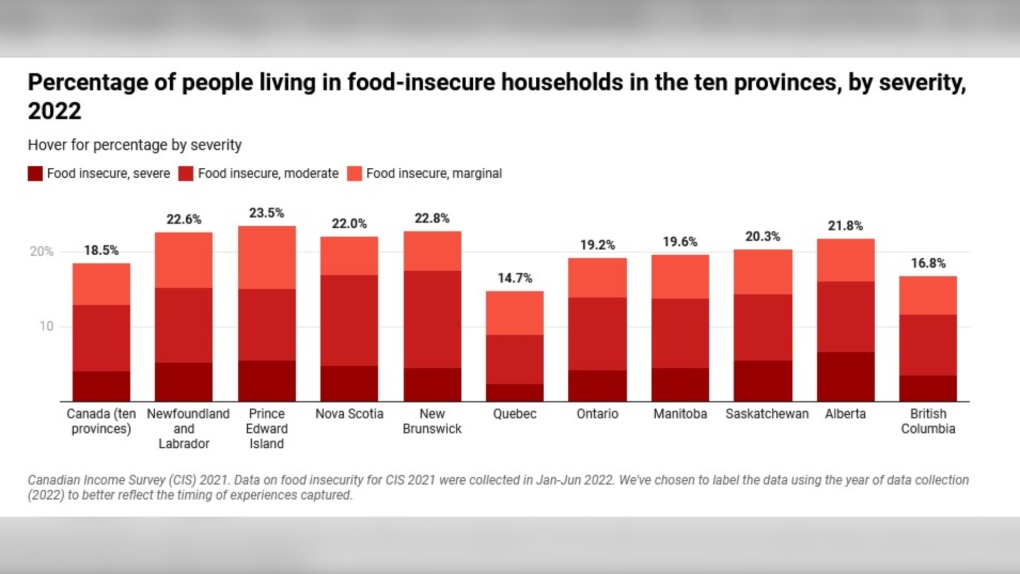Nova Scotia opposition pushes for universal school lunch program
New data highlights how more than one in five Nova Scotia households are food insecure, prompting opposition parties to renew calls for a universal school lunch program.
“Nova Scotians that are hungry right now can’t wait any longer,” said Zach Churchill, Nova Scotia’s Liberal leader.
Churchill told reporters a universal lunch program would help keep kids fed during the school day with healthy food and take the financial pressure off families struggling to make ends meet.
“I think the point of a school lunch program is actually equity — that kids are on a level playing field,” said Claudia Chender, Nova Scotia’s NDP leader.
Most schools in Nova Scotia offer breakfast but so far, the government has not introduced a province-wide lunch program.
“We are looking at bringing in a lunch program but we’re looking to work with our federal counterparts on that as well,” said Brian Wong, the minister of advanced education, speaking on behalf of the minister of education Thursday.
“Our previous government had eight years in order to bring in a lunch program and failed to do so, we’re absolutely working on it,” Wong said.
When Churchill was asked why the lunch program wasn’t brought in during his time in government he said the Liberals did expand the breakfast program and increase education funding.
“It was our plan to also bring in a lunch program and now we’re taking up that cause in opposition,” he said, noting how they’ve brought forward a bill to do that in the legislature twice.
“And we’ll keep doing that until the government hopefully approves it,” Churchill said.
Statistics Canada data analyzed by the research program Proof shows in 2022, 6.9 million people in 10 provinces, including almost 1.8 million children, lived in food-insecure houses.
Rates of food insecurity were highest in the Atlantic provinces:
- 23.6 per cent in P.E.I.
- 22.7 per cent in New Brunswick
- 22.5 per cent in Newfoundland and Labrador
- 22 per cent in Nova Scotia
Prince Edward Island has a universal school lunch program.
Lisa Roberts, executive director of Nourish Nova Scotia, said P.E.I.’s program is thanks to significant government investment and a pay-what-you-can approach. In that province, families can contribute to the program.
“Nobody can see in the cafeteria lineup if a family has paid $1 for the meal, or $4 for the meal or nothing for the meal,” said Roberts.
She noted how in Nova Scotia, school food programs aren’t all rolled out the same.
“Some schools have cafeterias, some don’t,” Roberts said. “We haven’t really tackled it yet with a systemic approach.”
 Percentage of people living in food insecure households in the 10 provinces, by severity, 2022. (Source: Proof)
Percentage of people living in food insecure households in the 10 provinces, by severity, 2022. (Source: Proof)
A provincial spokesperson said the Department of Education and Early Childhood Development is working with the federal government to achieve a universal lunch program for Nova Scotia.
“Federal funding for this program is an incredible opportunity and Nova Scotia wants to make sure that we leverage that,” said Barbara Ferguson, adding the province is well-positioned to have a program up and running.
“We are very eager to see this program come to fruition and have been laying the groundwork to make this happen, Ferguson said.
For up-to-date Nova Scotia news, visit our dedicated page.
CTVNews.ca Top Stories

Joly, Blair condemn anti-NATO protest in Montreal that saw fires, smashed windows
Federal cabinet ministers condemned an anti-NATO protest in Montreal that turned violent on Friday, saying 'hatred and antisemitism' were on display.
Canada's top general takes on U.S. senator in defending womens' role in combat units
Canada's top general firmly rejected the notion of dropping women from combat roles — a position promoted by president-elect Donald Trump's nominee for defense secretary — at a security forum underway in Halifax today.
Transit supervisor assaulted with 'torch' made of hairspray can and lighter: police
A Winnipeg man has been charged after a transit supervisor was assaulted with a makeshift torch in the city’s downtown area Friday morning.
NEW Thinking about taking an 'adult gap year'? Here's what experts say you should know
Canadian employees are developing an appetite for an 'adult gap year': a meaningful break later in life to refocus, refresh and indulge in something outside their daily routine, according to experts.
'Her shoe got sucked into the escalator': Toronto family warns of potential risk of wearing Crocs
A Toronto family is speaking out after their 10-year-old daughter's Crocs got stuck in an escalator, ripping the entire toe area of the clog off.
Canada's new income tax brackets in 2025: What you need to know
The Canada Revenue Agency has released updated federal income tax brackets for 2025, reflecting adjustments for inflation. Here’s the breakdown.
Canada's tax relief plan: Who gets a cheque?
The Canadian government has unveiled its plans for a sweeping GST/HST pause on select items during the holiday period. The day after the announcement, questions remain on how the whole thing will work.
Prime Minister Trudeau attends Taylor Swift's Eras Tour in Toronto with family
Prime Minister Justin Trudeau is a Swiftie. His office confirmed to CTV News Toronto that he and members of his family are attending the penultimate show of Taylor Swift's 'The Eras Tour' in Toronto on Friday evening.
Walking pneumonia is surging in Canada. Is it peaking now?
CTVNews.ca spoke with various medical experts to find out the latest situation with the typically mild walking pneumonia in their area and whether parents should be worried.


































